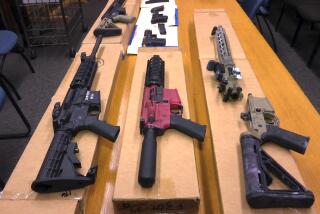Op-Ed: The boring truth about 3-D printed guns
- Share via
It’s rare in 2018 for even the most shocking news story to hold public attention beyond a 48-hour window, but it has been weeks since the State Department agreed to let Austin, Texas-based Defense Distributed resume hosting its digital firearms files at DEFCAD.com, and the media frenzy has yet to fully abate. After several state attorneys general sued to block the settlement, a Seattle judge granted a temporary restraining order, and a hearing is set for Friday.
Frenzy, and fear, are perhaps rational responses if you think the following summary is accurate: “Anyone can now download blueprints that enable them to 3-D print undetectable, untraceable, fully functional guns in the privacy of their own home.”
But every part of that sentence is either misleading or wildly exaggerated.
Let’s start with the word “now.” From skimming news stories, you’d think the State Department settlement had suddenly made available these digital source files. Actually, they have been legally obtainable on the open web for years via the Internet Archive, and in other digital media, like USB drives and DVDs. All the settlement did was allow Defense Distributed to host these files at its own URL.
It has long been the case that anyone can drop $25 at Home Depot and pick up enough parts to fabricate a perfectly legal, serviceable shotgun.
It’s also deceptive to suggest that criminals can take their homebrew guns through metal detectors. Only a fully plastic gun is undetectable; but a fully plastic gun is dangerously fragile and unusable after the first shot. And even an all-plastic gun requires metal bullets. (For what it’s worth, it has long been illegal to manufacture an undetectable gun.)
Then there’s the assertion that 3-D printed guns are “untraceable,” meaning they lack a serial number tying them to a specific manufacturer and retail transaction. But there’s no law against making such a weapon for personal use. Furthermore, the benefits of gun tracing have been vastly oversold. Canada shut down their national long-gun registry because it was too expensive and didn’t have a clear effect on crime rates.
Finally, with the exception of the all-plastic single-shot Liberator pistol, the “guns” one would make from the DEFCAD.com files are not, in fact, “fully functional guns,” but parts, which one must then combine with other parts that have long been freely available for purchase online. (Unlike the classic rifles and revolvers of the Old West, modern guns are designed to be taken apart and customized or upgraded by amateurs.)
Most important, it has long been the case that anyone can drop $25 at Home Depot and pick up enough parts to fabricate a perfectly legal, serviceable shotgun. You can find examples of such tinkering all over YouTube, and if the maker isn’t prohibited from owning a gun, he or she isn’t breaking the law.
The gun-control crowd is in a panic and is peddling its alarmist narrative because the facts outlined above reveal the absurdity of the so-called feature-based approach to gun control.
Under this outdated approach, governments outlaw certain types of firearms by make and model, or restrict (easily alterable) features like magazine capacity or the presence of a vertical foregrip. But it’s trivial to circumvent legislation like the Clinton-era Assault Weapons Ban, or the statewide bans that followed the national law’s expiration in 2004, because modern guns are modular — designed to have their features changed by swapping out widely available parts. The very existence of the “3-D printed gun” makes it painfully obvious that feature bans are untenable in the era of mass-market customization.
Enter the Fray: First takes on the news of the minute from L.A. Times Opinion »
Defense Distributed’s mercurial, anarchocapitalist founder, Cody Wilson, is quite explicit about trying to create facts on the ground that make all gun regulation pointless, telling Wired in a recent interview: “All this Parkland stuff, the students, all these dreams of ‘common sense gun reforms’? No. The internet will serve guns, the gun is downloadable.”
If we’re going to have gun regulation in a world where the jig is well and truly up, then we’ll have to switch from trying to regulate the “what” to regulating the “who.” This could mean treating guns like the many other controlled substances that can be easily manufactured at home — marijuana comes to mind — and focusing on licensing and permitting citizens to possess these items, regardless of where they came from, or how they’re configured, or whether or not they have serial numbers.
Under current law, it’s legal for you to possess a gun if you haven’t been explicitly flagged by the system as a prohibited person. Something like a federal license for simple possession of semiautomatic weapons would turn the current blacklist-based model into a whitelist, giving law enforcement a new tool to prosecute criminals, terrorists, domestic abusers and others who can’t pass a vetting process but who get caught with firearms.
Instead of exploiting the rise of 3-D printing to stoke mass panic and compound unenforceable bans on gun parts with even less enforceable bans on digital files, gun-control advocates should use this opportunity to review the elements of their agenda that are hopelessly out-of-date. And they should start innovating as quickly as the Cody Wilsons of the world.
Jon Stokes is the co-founder of Ars Technica, a contributing editor to TheFirearmBlog.com and founding editor of AllOutdoor.com
Follow the Opinion section on Twitter @latimesopinion or Facebook.
More to Read
A cure for the common opinion
Get thought-provoking perspectives with our weekly newsletter.
You may occasionally receive promotional content from the Los Angeles Times.









